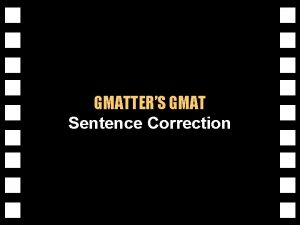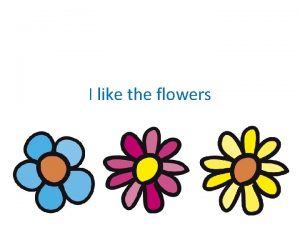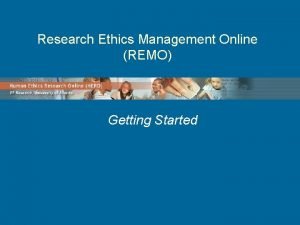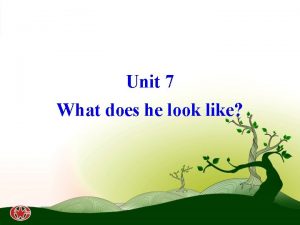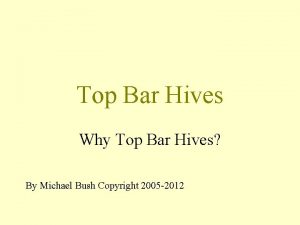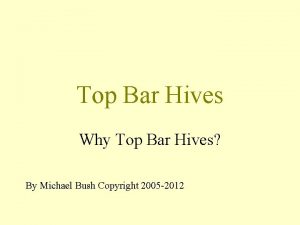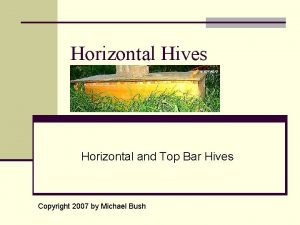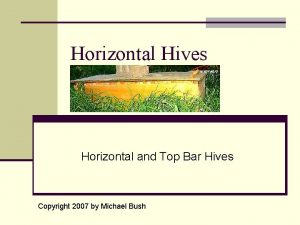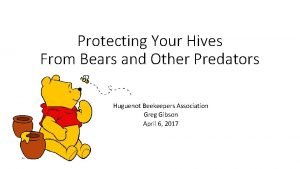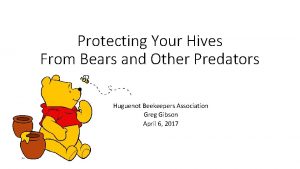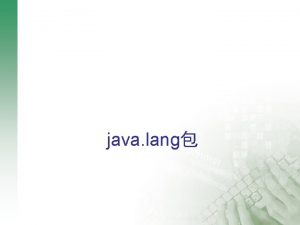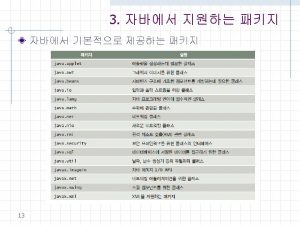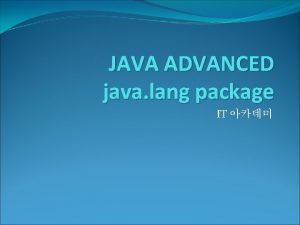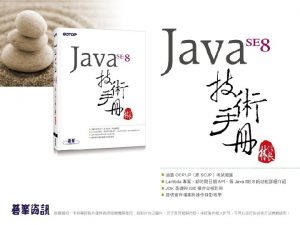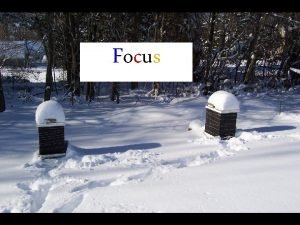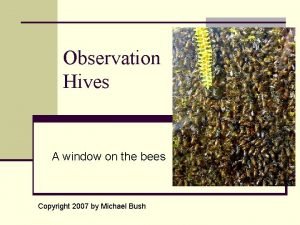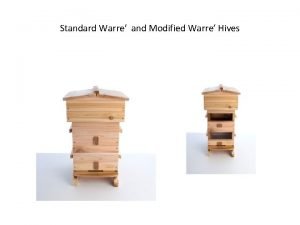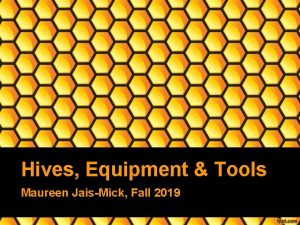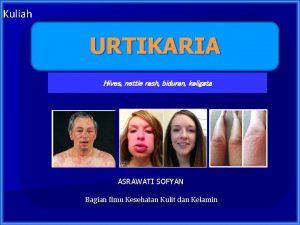Other hives The lang The Lang Like a









































- Slides: 41

Other hives…

The ‘lang’

The ‘Lang’ • Like a filing folder • Wax foundation • Supers


Horizontal TBH

h. TBH • PROS Less invasive Free to wander New comb each season No Supers Inexpensive Less hardware to store Extract smaller batches Kill less bees Easier for bee-ginners CONS More frequent inspections No standardisation Less honey


A permaculture beehive design • Ethics – What is important? • Principles & patterns – What principles & patterns in nature inform our design? • Strategies &Techniques – What are appropriate responses to the above?

Permaculture Pyramid MINIMAL INTERFERENCE Small Let bees requeen apiaries, but themselves TECHNIQUES Trapezoid enough for cavity genetic Minimising treatment diversity Natural comb Mesh bottombuilding boards Diversity is health (genetic, environmental) OBSERVATION: bees in nature ‘GREAT MYSTERY’ & TRUST PRINCIPLES Ecological interconnectedness/ PATTERNS co-evolution NATURAL SELECTION & ETHICS c REGENERATION FAIR SHARE

HONEYBEE HEALTH

What are the health problems bees face today?

Parasitic Varroa destructor • Co-evolution w apis cerana • Jumped ship in 1963 • Sucks bee-blood AND introduces viruses • First detected in NZ in 2000 • Beekeeping in NZ will never bee the same



Principles… • Mites need brood to reproduce, and they mostly live in brood. • Show 8 x preference toward drone brood than worker brood (capped longer + more space? ) • Mite pop. growth is exponential

Short-term ‘solutions’ • Apistan, Bayvarol, Apivar • ‘These pesticides should be considered hazardous. ’ Disposed of as ‘toxic waste. ’ • Often left in the hive too long • Users are encouraged to ‘alternate control methods to avoid immunity-building in the parasite’ • Users advised to not use fluvalinates before harvesting honey lest it contaminate product.

Organic chemicals Essential oils and organic acids • Essential oils – plants’ natural protection • Kills less varroa, can also be toxic to bees • Taste residues • THYMOL (66 -98% mite kill). Vaporizer – air temp must be 12 C+. Does not penetrate capped brood. (Apiguard or Apilife VAR) • Organic acids formic, oxalic, lactic. • Occur naturally in honey (trace quantities) • Formic acid – labour intensive, hazardous to use (burns skin + eyes, fatal if swallowed, fumes can ignite), affects drone eggs – and we don’t know how it actually works! • Oxalic acid – kills 98% mites. But corrosive… • Lactic acid caused up to 60% of bee eggs to be removed… advice is to ‘only apply to brood-less colonies. ’

Supermites – a silent spring • “Varroa is likely to build up resistance to all pesticides (chemical and organic) given enough time and misuse of products. ”

‘Biotechnical’ control • 1. Brood removal (esp. drone brood ‘trapping’ in a brood-less colony) – ‘ 5 week Hive-splitting varroa control’ (Vietnam method) – Isolating queen on one comb for drone trapping • 2. Mesh bottom boards – 20% natural mite fall from bee-grooming – Sticky boards / open bottoms prevent mites from climbing back up into hive – Not a stand-alone control but good for monitoring • 3. Heat treatment? – Why? Adult female mites more sensitive to temps above normal brood temp than brood themselves. How? Isolate brood, 44 C for 4 hours kills 100% mites and 5% brood (+ potential deformities later). • 4. Pollen traps? Nah. • 5. Smaller-cell foundation? Nah.

• ‘Varroa tolerance’ = ability to co-exist • Remember A. cerana? – Removes mites from infested cells and re-caps – Has a short yearly drone production period, and capped stage for worker brood too short for mites to reproduce in them – ‘Entombs’ mites in drone cells – Grooms – Significant absconding + swarming, leaving infested brood behind Apis cerana, the Asian honeybee: coevolved with varroa

• Which traits are worth selecting for? – Hygenic behaviour (not really significant) – Duration of capped stage (difficult, timeconsuming) – Suppression of mite reproduction (very worthwhile exploring!) – Brood ‘unattractiveness’ to mites (needs more research) – Grooming (not significant)

• Brood-unattractive Russians • ‘Live and let die’ • Selecting queens and breeder drones with a shorter capped period • Selecting for lowinfestation (combination of miteresistant traits)

Brood diseases (AFB, chalk) • ‘Chalkbrood’ often caused by fungicides in pollen – prevents natural fungi from preserving bee food, which rots. • ‘American Foulbrood’ = VERY NASTY. Bacterium Paenibacillus larvae in two forms: spore + vegetative. AFB spores fed to bee larva by nurse bees – spores germinate in gut. Vegetative form is rods that penetrate larval gut wall, multiply, consume tissue – larva dies in pre-pupal stage. It’s kind of like Alien. THEN vegetative rods turn back into new spores (1 diseased larva contains 2. 5 billion spores) – house bees spread spores by trying to clean out diseased larva – VICIOUS CYCLE.

Wax moth • Better thought of as symbiotic organisms in the hive • Cannot digest new comb, only old fouled comb • Best to freeze honey after harvesting to kill WM larva, lest they hatch and eat it all.

Wasps

Laws affecting beekeepers in NZ • Councils often have by-laws affecting beekeeping – check them out • You must register your apiary because hives must be annually inspected for AFB by an ‘approved beekeeper. ’ Do an Annual Disease Return. Destroy any AFB hive. • www. biosecurity. govt. nz – what you can and cannot import bee-wise • Toxic honey management (tutin from tutu plant, produced as honeydew by passion vine hopper – no taste or smell, can be deadly) • Pesticide management


Fundamentals • Permaculture design: Ethics underlie everything. • Trust the bees – it’s ok to not understand control everything. • Hobbyist / small-scale bioregional beekeeping is vital

What is going to save bees? • Perennial polycultures – abundant forage • Locally adapted genetic diversity • Enough hives to sustain losses











Objectives: Do we? • Understand pros and cons of top-bar? • Feel more comfortable around bees and beekeepers? • See beekeeping through a permaculture lens? • Trust the process? ?

Where to from here?
 Using a doppler ultrasound device gmat
Using a doppler ultrasound device gmat Self initiated other repair
Self initiated other repair Maybe it's maybelline slogan
Maybe it's maybelline slogan Halloween falls on october 31 every year
Halloween falls on october 31 every year Like father like son in italian
Like father like son in italian Why does ethanol look like water but behave more like wood?
Why does ethanol look like water but behave more like wood? I like the flowers
I like the flowers L would rather
L would rather Like minds like mine
Like minds like mine Language
Language Remo ualberta login
Remo ualberta login What he looks like or how he looks like
What he looks like or how he looks like Which is worse stealing like karl or cheating like bob
Which is worse stealing like karl or cheating like bob Which features of the sun look like huge cloud-like arches?
Which features of the sun look like huge cloud-like arches? What he looks like or how he looks like
What he looks like or how he looks like Nguyên nhân của sự mỏi cơ sinh 8
Nguyên nhân của sự mỏi cơ sinh 8 Trời xanh đây là của chúng ta thể thơ
Trời xanh đây là của chúng ta thể thơ Gấu đi như thế nào
Gấu đi như thế nào Thiếu nhi thế giới liên hoan
Thiếu nhi thế giới liên hoan Phối cảnh
Phối cảnh Một số thể thơ truyền thống
Một số thể thơ truyền thống Thế nào là hệ số cao nhất
Thế nào là hệ số cao nhất Slidetodoc
Slidetodoc Sơ đồ cơ thể người
Sơ đồ cơ thể người Tư thế ngồi viết
Tư thế ngồi viết Các số nguyên tố
Các số nguyên tố đặc điểm cơ thể của người tối cổ
đặc điểm cơ thể của người tối cổ Cách giải mật thư tọa độ
Cách giải mật thư tọa độ Các châu lục và đại dương trên thế giới
Các châu lục và đại dương trên thế giới Thang điểm glasgow
Thang điểm glasgow ưu thế lai là gì
ưu thế lai là gì Thẻ vin
Thẻ vin Cái miệng bé xinh thế chỉ nói điều hay thôi
Cái miệng bé xinh thế chỉ nói điều hay thôi Các châu lục và đại dương trên thế giới
Các châu lục và đại dương trên thế giới Bổ thể
Bổ thể Từ ngữ thể hiện lòng nhân hậu
Từ ngữ thể hiện lòng nhân hậu Tư thế ngồi viết
Tư thế ngồi viết V cc cc
V cc cc Làm thế nào để 102-1=99
Làm thế nào để 102-1=99 Thơ thất ngôn tứ tuyệt đường luật
Thơ thất ngôn tứ tuyệt đường luật Chúa yêu trần thế alleluia
Chúa yêu trần thế alleluia Hươu thường đẻ mỗi lứa mấy con
Hươu thường đẻ mỗi lứa mấy con
